L.L. Diamond's Blog, page 14
May 22, 2018
Muckross House and Torc Waterfall
While in Killarney National Park, one common tourist attraction is Muckross House. Finished in 1843, Muckross House was built by Henry Arthur Herbert next to the picturesque Muckross Lake. The house is now furnished in the style of the 19th century and has several furniture pieces crafted locally back in the day. There are also renovations from when Queen Victoria visited the house in 1861.
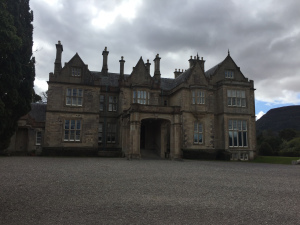
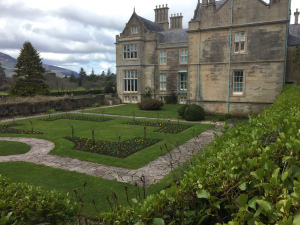
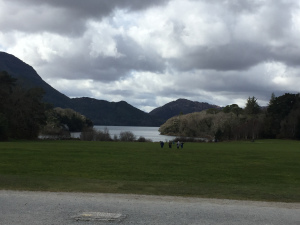
Muckross House is by tour only, so when you arrive, you pay and sign up for a guided tour. The tour takes you through nearly all of the house and is extensive. Unfortunately, they do not allow photos inside the house, so I cannot share any from inside the house with you. I can, however, share a few from the gardens.
After our tour of Muckross House, we walked to Torc waterfall, which is not far from Muckross Lake. It is a popular tourist attraction and lots of the bus tours of the area stop to see the falls. They are lovely and it was nice to simply sit and watch them. There are additional stairs to climb Torc Mountain and view the lakes below, but my daughter and I opted to sit near the base of the waterfall and enjoy it since our legs were rather tired from all of the walking.
While I loved Killarney National Park, I found myself disappointed with Muckross House. Maybe I’ve been spoiled a bit by National Trust Homes in England, but I felt let down after the tour. I also don’t care much for guided tours since I enjoy taking my time and studying the artwork and not being hurried along to keep up.
I did enjoy the grounds and Torc Waterfall is definitely worth the stop. However, there is a car park just off the main road that is much closer than parking and walking from Muckross House.
Next up … Galway and Cliffs of Moher!
Sources:
http://www.muckross-house.ie/house-garden.html
May 8, 2018
Kerry
From Rock of Cashel, we continued driving west to County Kerry where we toured for two days. We stayed in a great Airbnb home near Kenmare and drove out from there. The location turned out to be perfect since we were situated right at the beginning of the Ring of Kerry, which is what we did on the first full day.
If you’re wondering what the Ring of Kerry is, it’s a drive actually. If you’ve ever driven down Highway 1 in California, it reminded me a little of that except it curves down through the town of Killarney as well as Killarney National Park. It’s a 3-4 hour drive (approx. 110 miles) of quaint Irish villages, forests, rocky coastlines, and a few sandy beaches along the way—and a castle or two of course. We really didn’t stop for any of the castles. We stopped more for scenic vistas than anything else.
Driving out from Kenmare, we set off mostly through the forest, though you could see the bay peeking through the trees. Not all of the drive was directly along the coast, which made for some amazing views with the pastoral landscape in the foreground.
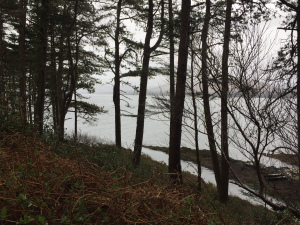
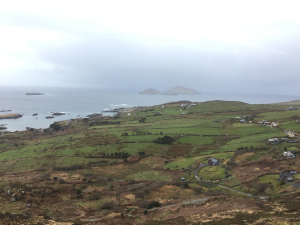
As we curved south toward Killarney, we stopped at the Gap of Dunloe, a rather narrow pass between MacGillycuddy Reeks and Purple Mountain. This amazing place was formed by glacial flows and where the Loe river now flows. We followed the GPS/SatNav until we reached a small cafe. We briefly stopped thinking we could drive no further. The weather had been rainy all day and it was still a bit drizzly when we arrived. There is a horse and cart for hire than can take you out along the small winding road into the Gap, but we didn’t take one. I will say that when we mentioned driving, the cart drivers told us not to even though we saw a lot of cars driving out from the road.
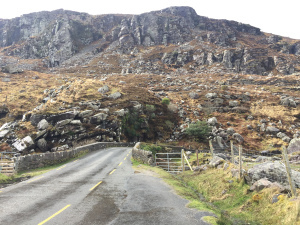


Since the weather seemed to be clearing a bit, we decided to chance it and drove down to a small lay-by on the other side of the “Wishing Bridge.” It’s said that wishes made on the bridge come true. I wish I’d known that at the time. We then walked around the bridge and took pictures before walking back to the car and driving a little further. Worried we might not find a better place to turn around, we turned back before the end and headed back along the Ring of Kerry towards Killarney.
Killarney is a neat town and we stopped in for a late lunch and to grab a few groceries for breakfast the next morning before we drove back through Killarney National Park, finishing the Ring.
The road through Killarney National Park is much more windy and a little more narrow than the road along the rest of the Ring of Kerry. That said, there are lay-bys where you can get out and take pictures of the more picturesque views. Killarney National Park is a mountainous area where you can see the highest mountain range in Ireland as well as the Killarney lakes.
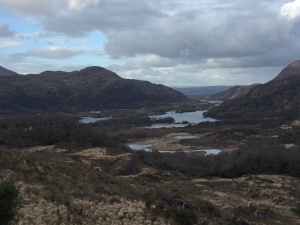
The park is a total of 25,425 acres and became a national park in 1932 when Muckross House was donated to the country. It is now a UNESCO Biosphere Reserve and a Special Area of Conservation as it contains the only Red deer herd remaining in Ireland as well as Sika deer which were introduced for hunting by the owners of Muckross house in the 1860s. We had one a Sika deer cross the road in front of us during one of our drives through the park. Thank goodness I wasn’t driving very fast!
The Ring of Kerry and Killarney National Park are definite must-sees for this part of Ireland. I wish we’d had more time to see a lot of the little bits and pieces we missed along the way.
Next stop: Muckross House and Torc Waterfall
Sources:
http://www.theringofkerry.com/the-gap-of-dunloe
May 1, 2018
Rock of Cashel,
After two days in Dublin, we packed up and loaded into the car for a drive to Kerry, but on the way, we took a little longer route to stop at Rock of Cashel. Rock of Cashel (Carraig Phádraig) has also been called St. Patrick’s Rock and Cashel of the Kings. Sitting high on a bed of limestone, Rock of Cashel is a Medieval castle located on the edge of the town of Cashel in County Tipperary.

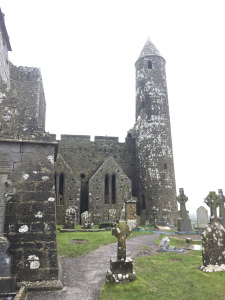
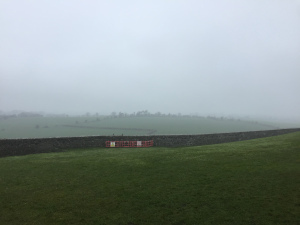
According to legend, Rock of Cashel is where Aenghus the King of Munster by St. Patrick in the 5th century. It was also the seat of the High Kings of Munster before the invasion of the Normans in 1101. What is present at the site now was built in the 12th and 13th century and includes the round tower (dating from 1100), Cormac’s Chapel (built 1127-1134), the cathedral (1235-1270). A graveyard surrounds the site where people are still buried to this day.
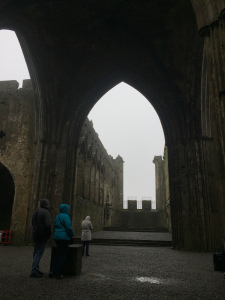
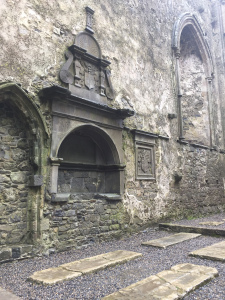
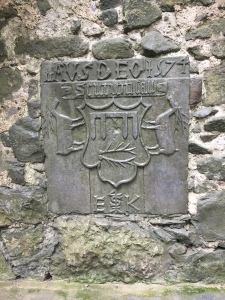
We had cold, foggy, rainy weather during our visit to Cashel, but it didn’t stop us. Rather, we made a detour into the wool store at the bottom of the hill for gloves and hats before we took the steep walk up. Admission is very reasonable, especially considering they have regular guided tours around the grounds. We didn’t follow one of the guided tours, but we did listen in to two of the tour guides as they talked to their groups. They had a lot of great details. For example, where most churches are built east to west in orientation of the gothic cross, Cashel is set the opposite. It’s said it brings bad luck.
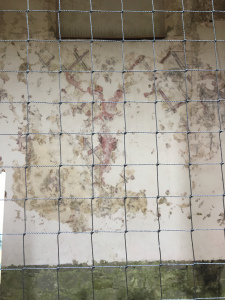
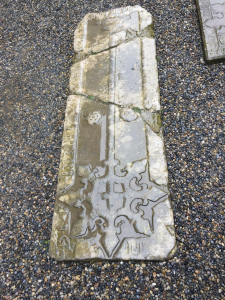
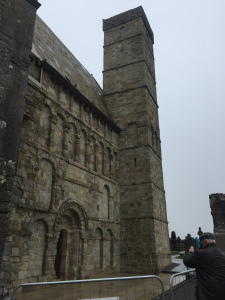
The cathedral itself is still sizeable, even in ruins. The clergy buried inside at the altar were moved at some point and have great carvings on the gravestones. The guides even show the small holes where lepers were once allowed to listen to the service.
Renovations were currently underway inside Cormac’s Chapel, so part of the grounds were blocked off. Cormac’s chapel is alongside the cathedral and almost seems much newer by the difference in the stone from the rest of the structure, however, it’s just as old.
If you’re out and about in Ireland, it’s definitely a must see!
Next up… Ring of Kerry, Killarney National Park, Gap of Dunloe
Sources:
http://www.cashel.ie/rock-of-cashel/
http://www.heritageireland.ie/en/south-east/rockofcashel/
https://en.wikipedia.org/wiki/Rock_of_Cashel
https://www.lonelyplanet.com/ireland/cashel/attractions/rock-of-cashel/a/poi-sig/491650/359751
April 23, 2018
Dublin!
For spring break, we planned a crazy circuitous route around Ireland. We started by driving to Holyhead, Wales to board a ferry that would take us to the port in Dublin. I’ve never been aboard a ferry before, but because the trip is a little over three hours, the ship is more of a mini-cruise ship. Two floors were dedicated to entertaining guests with a place to eat, a bar, a duty-free shop, and a small cinema, giving something for everyone in the family. We took the eight a.m. ferry and were in Dublin just after noon. While we travelled, we ate breakfast, my son watched a movie in the cinema, and the rest of us alternated between walking on the deck and working/homework.
Once in Dublin, we met the rest of our travelling party at Jervis shopping centre, checked into the flats where we would be staying, and a large part of our party went to the Jameson distillery for a tour while I stayed with the children. (I’m trying to get my husband to write a guest post for the tours he took that I didn’t.)
The next morning, we walked to Trinity College to see the Book of Kells and the Long Room. The Book of Kells is an illuminated manuscript made in the 9th century and details the four Gospels containing the life of Jesus. It is displayed along with other artefacts and very interesting, though you can’t take photos of the book. You can take photos in the old library long room, which is gorgeous and it’s nice to just sit and take in the surroundings.
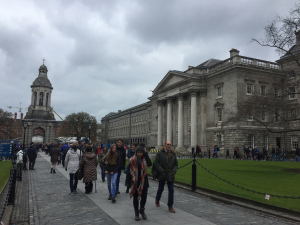
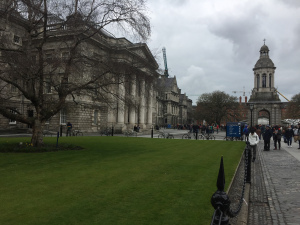
I definitely recommend purchasing your tickets ahead of your visit. We purchased ours online, which kept us out of the queue, but we still had a thirty minute wait until our show time. The manuscript was interesting and I loved the Long Room. I even found a Jane Austen link!

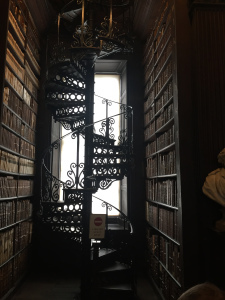
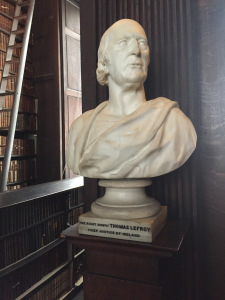
After Trinity College, we toured Christ Church Cathedral. Where the church sits began as a site of worship in 1028, and in 1108, the previous wooden structure was replaced with a stone building that was added to over time until it is what it is now.
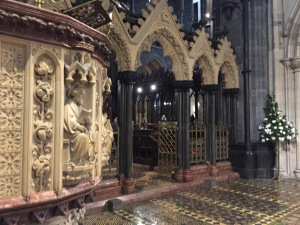
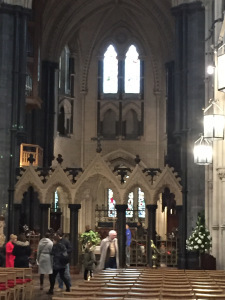
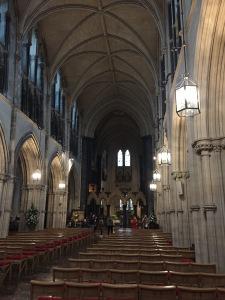
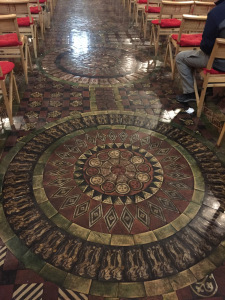
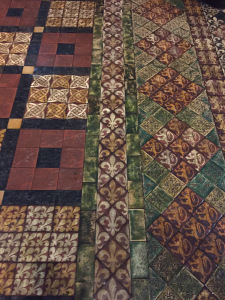
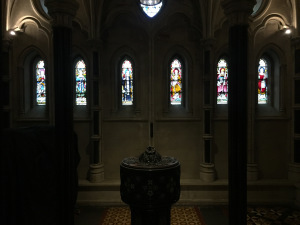
Christ Church Cathedral also has the largest crypt in the UK and Ireland. Visitors can walk around inside the crypt and there are also a number of exhibits down there. It’s said that at one time part of the blanket from the manger was stored down there.
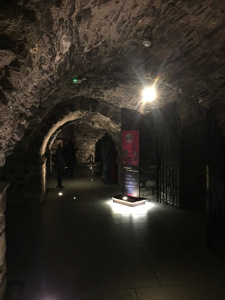
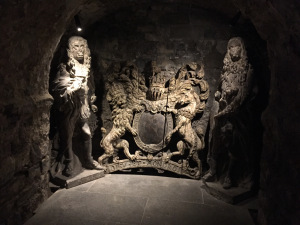
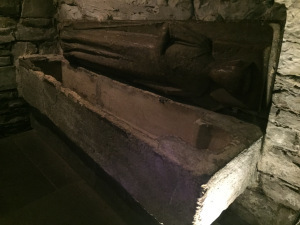
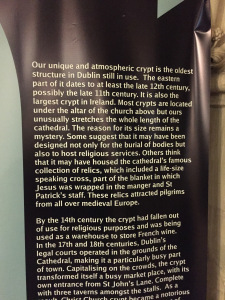
After, we walked down to St. Patrick’s Cathedral. History says St. Patrick baptised people on the site, which became a church in 890. The first cathedral was built between 1191 and 1212 and the current cathedral was built between 1220 and 1260. Like most large cathedrals, the original structure was added to over the years until it became what it is today.
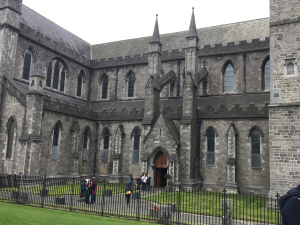
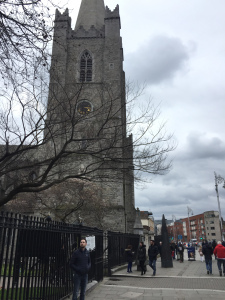

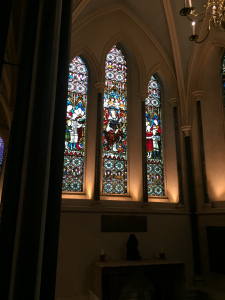
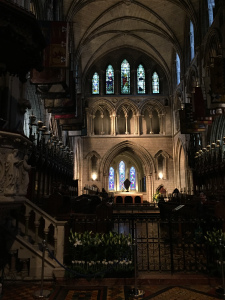
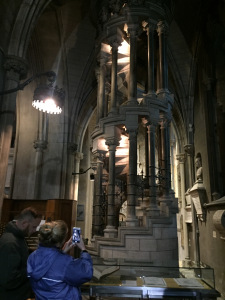
The inside of both cathedrals was amazing and definitely worth seeing! We walked and took pictures until we didn’t know what to take pictures of anymore. After we ate dinner and returned to the flat to get some sleep for the next day.
Next up! Day 2 of Dublin!
Sources:
http://christchurchcathedral.ie/about/history/
https://www.stpatrickscathedral.ie/learn/life-and-history/
April 10, 2018
Off to Belgium again!
Yes, I’ve been to both places before, but I had a reason to visit again, so we jumped at the chance. We took the Eurotunnel crossing again and drove to Mons first. We stayed in the same little farmhouse we did the last time though we didn’t make it into Mons until after dark this time and mostly on a quest for food.
We finally found a little restaurant that we decided to take a chance on. It wasn’t anything more than a small family owned place. It was simply called Henri. We took our seats and ordered drinks and prayed they could do something gluten-free since three of us are celiac. The menus did come in English as well as French, so if you decide to try it and don’t speak French fluently, then you can always request a menu. Fortunately, we were able to explain to the waitress what we needed and they let us know if what we wanted to order would work for us.
The food was wonderful and we thoroughly enjoyed ourselves after walking for a while trying to find somewhere to eat with the grocery stores all closed.
The next day, we drove into Brussels and walked around Grand-Place once again, bought chocolates at our favourite place, and rather than brave the search for gluten-free, ate at Hard Rock Cafe. We even stopped inside the Smurf store to look around. My son enjoyed a Belgian waffle too.
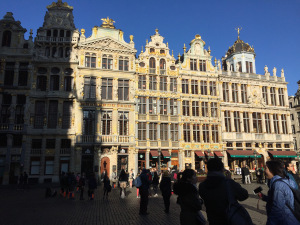
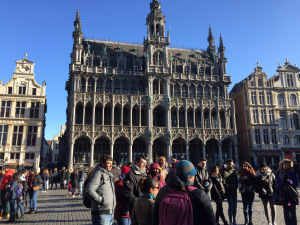
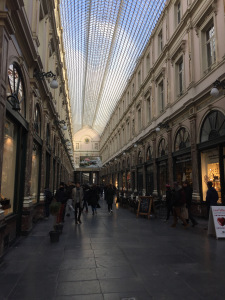
We only had about two hours before we had to leave because of parking, so we drove out to a park where we could get a good look at the Atomium from a distance. Atomium was built for the 1958 World’s Fair and today, houses a museum. Unfortunately, we didn’t have time to go inside since we had reservations on the Eurotunnel to return to the UK. Maybe next time 
March 20, 2018
Murano and Burano
One thing we didn’t get to do the last time we were in Venice was take a water taxi out to Murano and Burano. When you walk through Venice, the stops for the water taxis are scattered all over, but we just never thought to take one since you could see so much by foot.
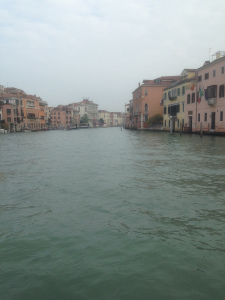
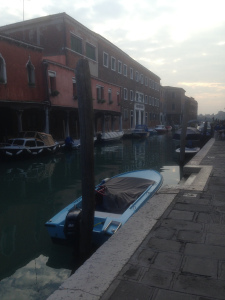
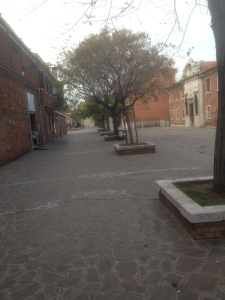
Murano is a cluster of islands located in the lagoon near Venice. A series of bridges link these small islands and allow for you to walk around Murano much like you would Venice. This part of Venice was originally settled in the sixth century and thrived as a fishing colony until the glass makers moved to this area to keep fires from breaking out in Venice. Since then, Murano has been all about glass. When you tour Venice, there are stores boasting of Murano glass and when you exit the water taxi, there are stores immediately off the boat selling everything from water glasses and hand blown animals to the ornate. They don’t allow pictures to be taken in the stores or the windows, so I searched out a photo of the ornate as an example.
[image error]
photo credit: Rauantiques
We paid for a day pass on the water taxis and started at Ferrovia, which is the stop just outside of the train station and travelled down the Grand Canal until we exited into the lagoon. We skirted along the Cimetero San Michele, an old island cemetery I’d love to walk through if I had the time and chance, until we reached Murano at the Colonna taxi stop.
We perused several shops and even bought a few small pieces of Murano glass (hopefully we didn’t get suckered into Chinese rip-offs!) and eventually walked to the Faro taxi stop where we boarded another boat headed to Burano.
As you approach Burano, the first thing you notice is how different it is to Murano as well as Venice because of the brightly coloured homes visible from the boat. Burano, however, is famous for its colourful homes as well as lace and seafood. We arrived in Burano late afternoon and our first stop was for food. We found a nice little restaurant, but little did we know what would come of this little adventure.
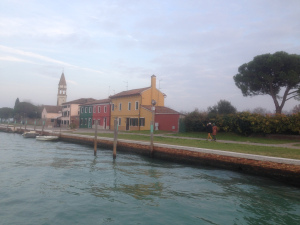
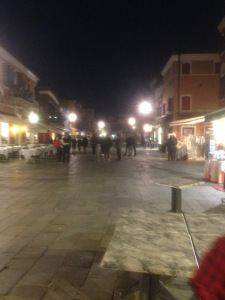
A number of restaurants around Venice have a seating charge, so they charge so much per person as soon as you are seated. This one not only had the seating charge, but each meal was actually more a meal for two or three people and the charge in the menu was per person. It added up quickly. That said, the food was incredible and the Prosecco, made homemade there was amazing, the bill left something to be desired at the end.
(The day had turned a little misty by the time we made it to Burano, so my photos weren’t great, but I found this one below to give an idea of how colourful the houses really are.)
[image error]
Burano by day
Photo credit: MarkusMark
By the time we finished our meal, it was getting dark, and everything in Burano was closing since it was a Sunday. We waited for a water taxi and boarded the first one even though it went to Treporti and then doubled back. We just wanted to sit. We took the boat to San Marco at the Piazza San Marco and then found a boat that took us back to Ferrovia so we could take the train back to Marcon.
If you go to Venice, Burano and Murano are not to be missed!
Next up! Mons, Belgium and Brussels!
Sources:
https://en.wikipedia.org/wiki/Murano
http://www.dailymail.co.uk/travel/destinations/article-5386153/guide-burano-venice.html
March 6, 2018
Venice the Sequel!
Yes, we took a trip to Venice last year around the same time of year and we decided to attend the same event this year, which meant another Thanksgiving in Venice! This time, however, we didn’t stay quite so close to Venice which had its pluses and minuses. Last year, we stayed in Mestre, which is just across the lagoon from Venice, and an easy tram ride from our flat to Venice. Mestre still has the tourist taxes that you pay in cash when you check in to any establishment, whether it’s a hotel or an Airbnb.
We stayed in Marcon this time at a lovely farmhouse situated just outside the business part of the city. We were close to a Carrefour for groceries. Since we were further out from Venice, we didn’t have the tourist tax that is paid within the city, but we didn’t have the tram. Not that getting into Venice was difficult. Instead, we drove to the local train station, which had free and easy parking, purchased a ticket on the platform (5 of us cost about 20 euro round trip), and the ride was about 20 minutes into Venice. The station is also a little further into Venice than when you take the tram to the station. The train did cost a little more than the tram, but (and this is a big but), tourist tax is 3 euros per person, per night. For five people and five nights, we would’ve spent 75 euros and then had to pay for the tram. We spent three days in Venice, which was 60 euros, so we still ended up paying less.
[image error]
Doge’s Castle on the Piazetta
Our first day, we wanted to cover what we missed during the previous year’s trip. We toured the Palazzo Ducale (Doge’s Palace). Built in the 14th and 15th century, it’s a huge Gothic building and boasts everything from amazing rooms with phenomenal artwork and sculpture, including Tintoretto, to the prison cells and the interior of the Bridge of Sighs. It’s definitely not to be missed!
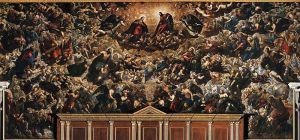
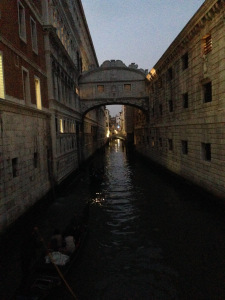
Included in the ticket for Doge’s Palace were several other nearby museums (Museo Correr, Museo Archeologico Nazionale and Monumental Rooms of the Biblioteca Nazionale Marciana.) We tried out Museo Correr, which was amazing if only our feet weren’t protesting from the walking. We did cut that one a little short and started to walk back in the direction of the train station until we found a place to sit and eat. The view from the Rialto at night was lovely, though I wish my picture was better!
Next up!! Murano and Burano!
Sources:
http://palazzoducale.visitmuve.it/en/the-museum/doges-palace/the-palace/
February 27, 2018
February Update!
Yes, I’m still kicking . . . and writing! LOL!
I still owe you blog posts on my last trip to Venice, but February last year and this year has been a busy time. I coach on a swim team that travels (which is why sometimes a place gets blogged twice!) and we had our Divisionals competition as well as Champs this month. It’s been a bit of a whirlwind, but the group of kids is amazing and I’m privileged to help them along. They always amaze me with their dedication and the ability to come through when it counts and improve. Most of our swimmers had personal best times, and that alone makes me celebrate.
On a writing note, I’ve completed the Christmas story I started in shorts during December. A bit has changed since then because it didn’t work as well in a longer format, but it’s in betaing at the moment and I plan on releasing it in time for the holiday season this year. I do plan on including the short story at the end for a bit of fun and for those who enjoyed it and would like having a copy in the book. 
January 23, 2018
Rome: Palatine Hill
Old plan of Palatine Hill
After the Colosseum and the Arch of Constantine, we checked out the lines for Palatine Hill. It was part of the admission for the Colosseum and we could see the ruins from outside and were definitely interested. We ended up having to go to lunch first. The lines were long before, but we hoped they might die down, which they did. By the time we were done eating, we had to simply show our ticket and walk through the gates.
Palatine Hill is the original site of Rome where mythology claims Romulus and Remus were found by the wolf Lupa and it is claimed Romulus built the sanctuary of the Curiae Veteres on one side of the city. This 131 foot plateau was the centre point of the Seven Hills of Rome and has a circumference of 5,700 feet. This site contains everything from prehistoric Roman ruins and later palaces and temples. It looks upon the Roman Forum on one side and Circus Maximus on the opposite and just a warning–bring your walking shoes!!
Evidence shows people have been living on Palatine Hill since the 10th century BC until the emperors made Palatine Hill their domain and built a series of palaces there. When the Roman Empire fell, Palatine Hill deteriorated until a stronghold was built in the Middle Ages. During the Renaissance, wealthy families built homes on Palatine Hill. Now, it’s an archeological site and still being excavated.
There’s just too much to Palatine Hill to go through it all and I know we didn’t even get to walk through all of it. It’s an entire day and maybe two if you are particularly thorough. The views from the top of the hill as well as the little bits that you find looking into some of the alcoves is worth every bit of it. It’s amazing to get a tiny glimpse of what existed here. Just by the ruins, you can see how amazing and fantastic much of it was.
[image error]
Panorama of Palatine Hill from a higher vantage point
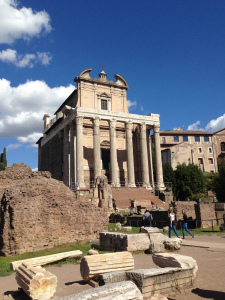
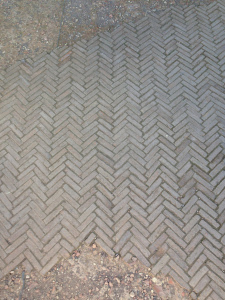
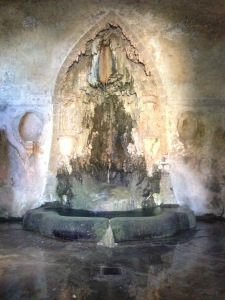
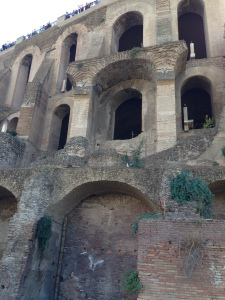
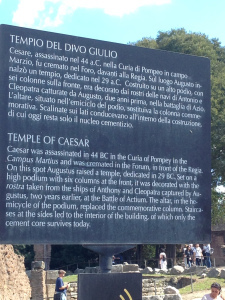
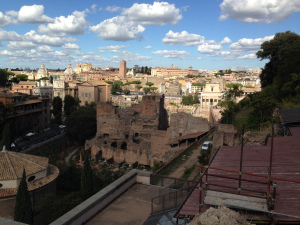
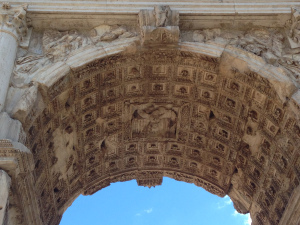

Next . . . we return to Venice!
Sources:
https://www.britannica.com/place/Palatine-Hill
https://en.wikipedia.org/wiki/Palatine_Hill



